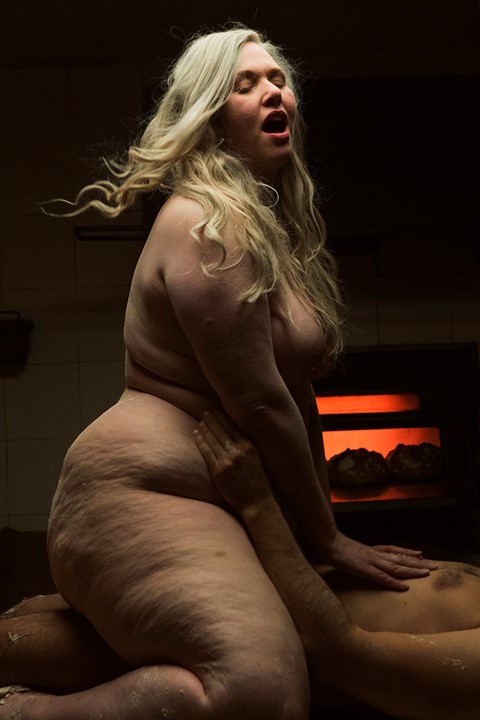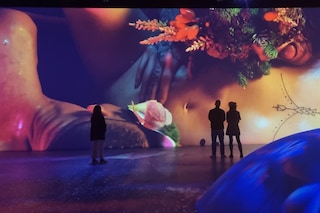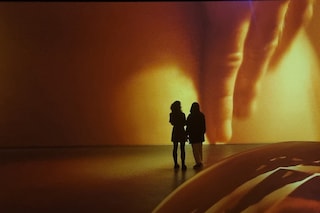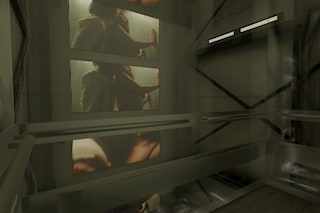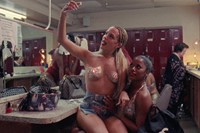The exact location of the House of ERIKALUST is a closely-guarded secret, up until the very last minute. That’s partly because the venue only transforms into an “avant-garde erotic art” exhibition after hours, playing host to a very different business in the daytime – but the mystery is also part of the fun. “We wanted you to be stepping into something secretive, something unexpected,” Erika Lust tells me ahead of time, in the glamorous lobby of Barcelona’s Casa Fuster hotel. “What we have created... here we get into a territory that is a little delicate in our sex-negative world.”
Appropriate, then, that visitors are led down a dim alleyway and through a nondescript back door to gain entry to her sex-positive alternate universe. The only real clue you’ve arrived? A small, backlit sign that reads: “Here at lust! Come in.”
On the inside, the real nature of the project becomes more explicit (literally). All visitors are handed a glittery black mask, à la Eyes Wide Shut, and ushered through a series of rooms that showcase Erika Lust’s work over the last two decades. In a section devoted to her XConfessions series, we see how the general public’s X-rated fantasies – Lust receives an average of 800 per year – are transformed into high-quality, cinematic adult films. In another room, we’re surrounded by erotic scenes on all four walls, complete with gasps and groans in immersive surround sound.
The pièce de résistance of the House of ERIKALUST, though, comes in the shape of an actual three-storey house, experienced via a chunky pair of VR goggles. Upon entry, visitors are prompted to select from three options (erotic, explicit, or surprise me) and we spend the next 15 minutes in a shared maze with NSFW scenes around every corner. Peeping through a keyhole reveals someone getting spanked, while touching a painting brings its figures to life. Later, in the library, I leaf through a virtual copy of the Kama Sutra beside the other visitors, who are represented as anonymous avatars – and strangely, the blank faces seem to defuse any discomfort we might experience IRL.
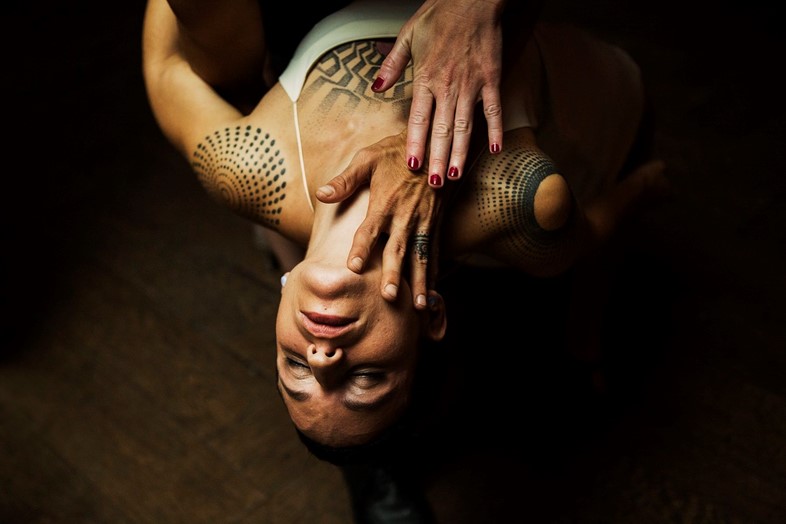
But let’s take a step back, just in case the name Erika Lust doesn’t ring a bell (despite her numerous awards, multiple books, and global recognition). Born in Sweden and based in Barcelona since 2000, Lust is a feminist filmmaker and pioneering porn producer. She made her first erotic indie film, The Good Girl, at film school in 2004 – having previously studied political science with an interest in feminism, gender studies, and queer theory – and today she finds herself at the vanguard of a growing conversation about diverse, feminist, ethical perspectives in porn. She also advocates for better sex workers’ rights and sex education, via platforms like The Porn Conversation.
“I always loved film, theatre, dance, music, art and photography,” she says of her first forays into filmmaking, and drew on the work of theorists such as Laura Mulvey and Linda Williams (the late author of Hard Core) for her themes. But her interest in eroticism was there from the start as well. “Humans are sexual beings,” she adds. “We have this desire to watch other people have sex. We like the erotic experience. It’s so basic to us… the things we need to do to perpetuate as a human race are food, drink, and sex, otherwise we wouldn’t be here at all.” Considering this, the question is less: ‘Why does she make films about sex?’ It’s more: ‘Why doesn’t more art, film, and writing centre on this fundamental feature of the human experience?’
We need to show that we are here... and that we have the right to desire, to be more than objects, to feel pleasure – Erika Lust
Not all porn is representative of the depths and complexities of human sex and romance, of course. “I wanted to do something about female pleasure,” Lust says of her debut, “but it was very clear to me that my desires didn’t fit in [with] the dominant discourse of pornography that was out there.” So, by contrast, she flipped the typical porn storyline – “the plumber, the pizza guy” – on its head, emphasising female agency both onscreen and behind the camera.
Today’s porn productions look very different to when she was starting out. For Lust herself, shoots now involve between 20 and 40 people, mostly identifying as female or LGBTQ+. People with on-set experience emphasise a positive, collaborative vibe, reflected in boundary-blurring films that show “behind-the-scenes” negotiations alongside the porn itself. (One, for example, sees the writer and director poolside with one of her performers, debating whether a gangbang can, in fact, be feminist.)
But the industry itself has undergone a massive shift as well, most notably due to “tube sites” like Pornhub and their dubious approach to issues of consent, safeguarding of minors, piracy and economic fairness. That’s not to mention the misaligned incentives of the broader internet economy, which constantly drives users to consume more (and more extreme) forms of content primed for addiction and instant gratification. See also: the complex topic of self-promotion surrounding newer platforms like OnlyFans.

Lust has mixed feelings about the changing face of porn in the age of the internet. “I mean, I wouldn’t be here if it wasn’t for the internet,” she admits, reminiscing on the beginnings of her online business in 2004. But then, “it was a very different time”. (In its early days, the business consisted of a Blogspot and a separate website to sell DVDs.) At the same time, despite the proliferation of online porn – estimated at more than 10,000 terabytes in 2022 – it’s become harder to conduct meaningful, nuanced, and diverse conversations about sex and sexuality on the public web. This is largely thanks to the heavy-handed censorship on major platforms owned by companies like Meta, which is only set to rise if conservative governments get their way.
It’s partly because of this shift, says Erika Lust, that it’s so important to “get porn out of the internet and into the real world” via experiences like the House of ERIKALUST, which might serve as an antithesis to the stereotypical image of a teenage boy or middle aged man hunched over his laptop in a darkened room. She recalls a series of Pornhub adverts that ran a few years ago, billing it as “the world’s biggest archive of nothing” as a joking reference to a user’s response when someone asks what they’re looking at. “But [sexual desire] is not nothing,” she argues. “It is something, and it’s something that you don’t have to feel ashamed of.” If Big Porn keeps failing us, she adds, “it’s necessary for us to live it from another point of view, to make culture and art out of it. To immerse [ourselves] in this world, then to talk about it.”
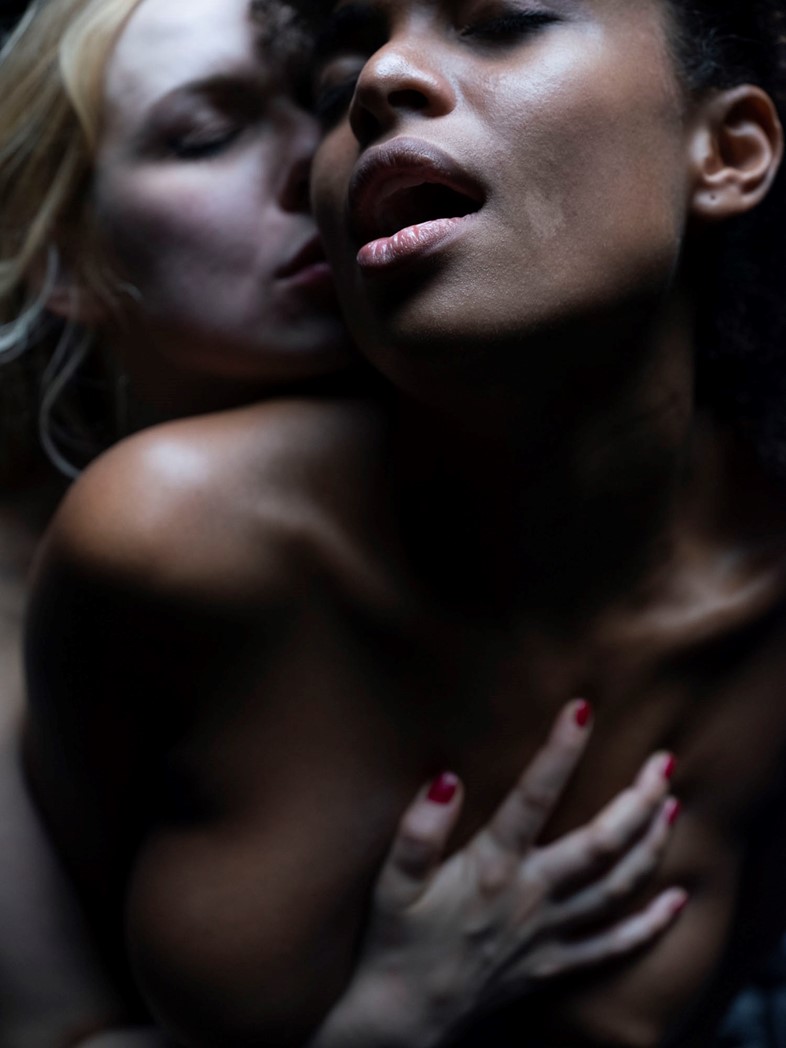
With the rise of new technologies like VR and AI, of course, comes a whole new set of concerns. Stats vary from study to study, but porn addiction is shown to be rising among young people across the world, while IRL connections – from dating to one-night stands – are on the wane. It’s hard to imagine that unregulated access to immersive, interactive tech will improve the situation, with AI chatbots already fuelling parasocial relationships and unhealthy emotional attachments. But this is all the more reason to get involved in the space, Lust says, especially amid a resurgence of conservative and patriarchal power. “We live in times where what we do is resistance, and I think it’s our obligation to keep on going. We need to show that we are here, what we think, what we believe, and that we have the right to desire, to be more than objects, to feel pleasure.”
“It’s so crazy how so many women, when they have sex with cis men, forget about themselves” – and, naturally, Lust hears from a lot of them – “even if [before] they were having great sex with themselves, or with their vibrators or whatever. We were brought up to think about sex that way.” She suggests that this extends to the whole concept of marriage, which has long served as a system to make women provide health care, child care, cleaning, and sex work in exchange for economic stability and security. “It’s a transaction. Most people don’t see it, but it’s actually there.”
If we want technology to open up in new ways, we need new people to step in there, to dare to understand it, to start playing around with it – Erika Lust
Going back to the VR experience in Barcelona, Lust’s embrace of new technologies is inseparable from her efforts to rebalance gender politics and expand our perspectives on human sexuality. That is, the content at the House of ERIKALUST and its multidimensional presentation leads to encounters with unfamiliar and unexpected expressions of gender and sexuality. But also, the medium itself sends a strong message. “When we talk about technology, the creators, almost all of them, have been guys, right?” she says. And when she made her first 360-degree VR film a few years ago, she had to work with these “guys” because they had a monopoly on the technology, but even then she says: “It was a struggle... I was proposing things they didn’t understand.” As a result, she decided to start playing around with the tech herself, and now encourages others to take a similarly curious, optimistic approach.
“Honestly? I was never very interested in technology, but I had to force myself to get in there and fuck around with it,” she says. “I mean, how else are we gonna get more power? If all technology is owned by Musk and Zuck and those guys, then how are we gonna change the world? They’re not gonna hold open the door for us. They use the technology to try to hold us down, hold us back. I had to let go of the idea that I’m not interested. I think that if we want technology to open up in new ways, we need new people to step in there, to dare to understand it, to start playing around with it, and to start failing. Because you can never learn anything if you’re afraid of failing.” Just like you won’t know what’s going on behind the door if you’re too afraid to bend down and peep through the keyhole. In the end, both the House of ERIKALUST and the rest of the world favour the curious.
House of ERIKALUST is open Thursdays, Fridays, and Saturdays from 9pm.

